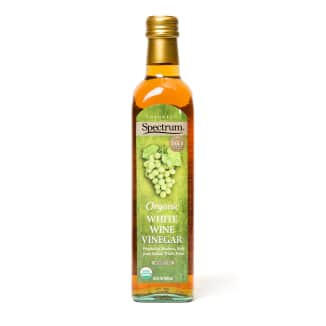As vinegars go, the red and white wine varieties are utility players: Neither is as distinct as sherry, balsamic, or cider vinegar; nor is either a go-to condiment for a particular dish as sherry is for gazpacho or balsamic is for strawberries. But that’s exactly what makes them valuable as pantry staples; a good version of either can deliver a jolt of clean acidity and balanced fruity sweetness to just about any dish. However, the white wine kind has a small but significant advantage: It doesn’t impart color, which can make it the better choice for seasoning pan sauces and soups or for pickling vegetables.
Since we last tasted white wine vinegars, several products have been discontinued or become hard to find. So we rounded up eight widely available vinegars, and tasted them, first in a simple vinaigrette served with mild salad greens and then simmered with sugar, salt, and herbs to make a flavorful brine for giardiniera, the classic Italian pickled vegetable medley.
From Vine to Vinegar
Most of the vinegars were well balanced, combining punchy acidity with a touch of sweetness. Tasters made note of samples that were on the “mellow” side or, conversely, were too bracing. Ultimately, we liked them all enough to recommend them (even the last-place vinegar seemed like a fine choice for vinegar lovers). However, one stood out from the pack; in addition to being well balanced, it boasted complex flavor that was “fruity,” “floral,” “aromatic,” and particularly “vibrant.”
One explanation for this vinegar’s exceptional flavor might be the wine itself. All white wine vinegar is made from white wine, which is typically processed in giant stainless-steel vats called acetators that expose the alcohol to oxygen and quickly convert it to acid. Manufacturers usually then dilute the vinegar with water to a specific acidity, between 5 and 7 percent (the acidity of all vinegars must be at least 4 percent). The particular wine that’s used to make vinegar is often hard to trace, since many manufacturers use a mix of wines or “wine stock,” a blend of lower-quality wines. But in the case of our winning vinegar, the manufacturer told us it uses wine made from Trebbiano grapes, a varietal known for being crisp and fruity. (Our runner-up wasn’t made from wine stock either but from a blend of four specific varietals that are also known for their vibrant, fruity flavors.)

Sour and Sweet
Our winning vinegar also stood out for its balance of strong acidity and subtle but distinct sweetness. In fact, this vinegar, Napa Valley Naturals Organic White Wine Vinegar, was among the most acidic vinegars we tasted. We gleaned this information from the product’s label, which listed 6 percent acidity, and confirmed this number with results from an independent laboratory, which tested the titratable acidity (a measure of how strong an acid tastes). That explains why it tasted “robust” compared with less acidic (about 5 percent acidity) vinegars, which tasted “mild” and “mellow.” That much acid would surely have tasted bracingly tart if not for a hint of sweetness. Again, the labels offered a clue. The bottom four products all contained zero calories per a 1-tablespoon serving. Meanwhile, most of our favorites contained a few, between 2 and 5 calories. Our winner contained the most. But this sweetness isn’t from added sugar; it’s an indication that the wine used to make the vinegar was sweeter than in the other products.
With bright, balanced flavor, Napa Valley Naturals Organic White Wine Vinegar deserves a place in your pantry. If you can’t find it, the best way to know that you’re getting a good vinegar is to check the label. The acidity percentage will be listed; look for at least 6 percent for the most vibrant flavor. As for the sugar content, the most balanced vinegars we tasted, particularly Napa Valley Naturals, had a few calories per serving, which indicates that it was made with a sweeter wine. That, along with its aromatic and floral flavor, makes our winner ideal for use in everything from vinaigrettes and brine to soups and pan sauces. We’ll keep this versatile vinegar in easy reach.
Different Color, Same Flavor
During testing, we noticed color variation among bottles of one particular white wine vinegar. Most were pale, while some were a rich amber. It turned out that the darker bottles were older (but still well within their use-by dates) and had oxidized due to light or heat exposure. But oxidized vinegar isn’t harmful, and we couldn’t taste a difference between the oxidized and nonoxidized samples.
- Taste plain
- Taste in our Foolproof Vinaigrette served with mild salad greens
- Honeyed, raisiny sweetness
- Bright, vibrant acidity
- Balanced sweetness and acidity













